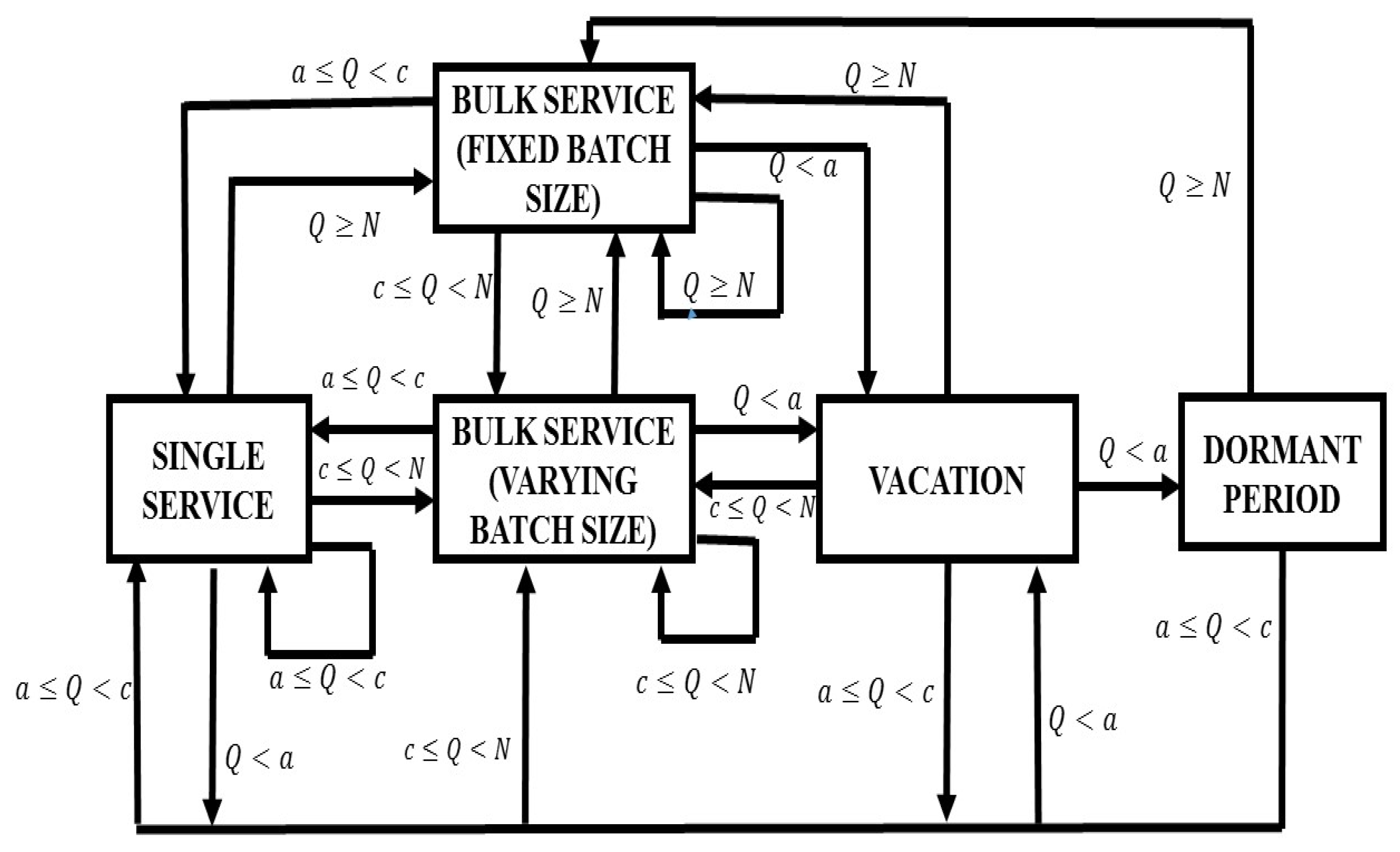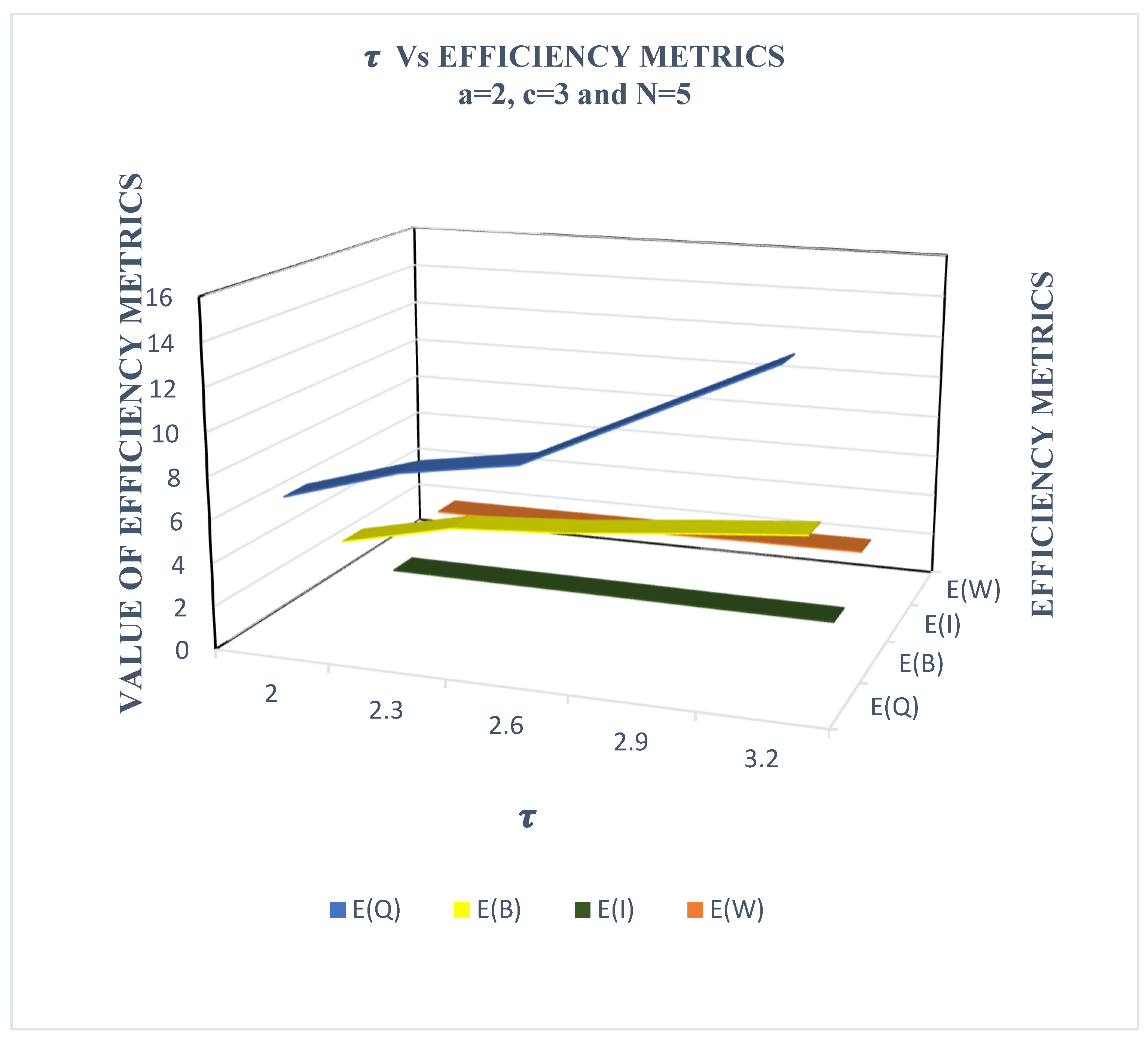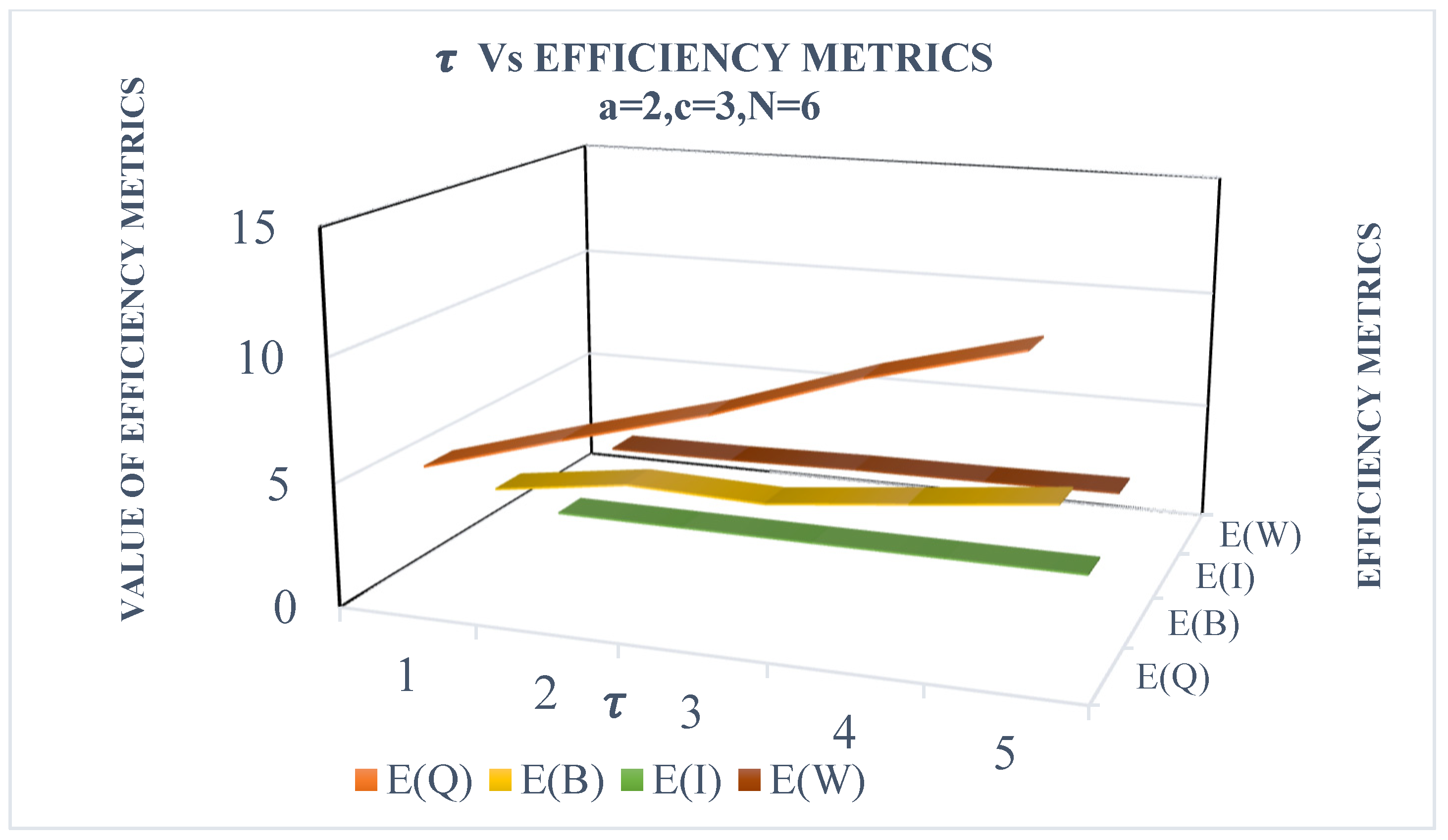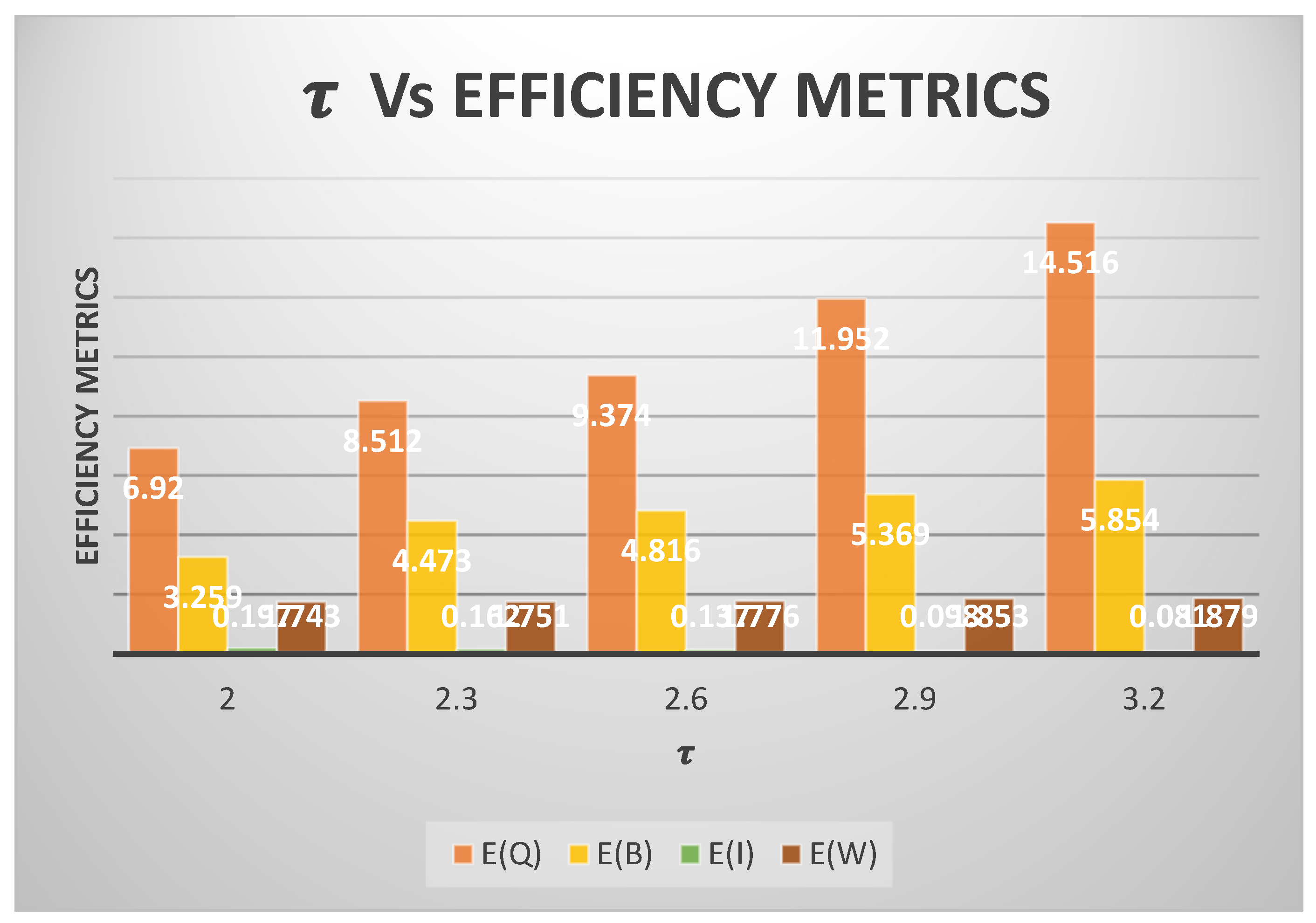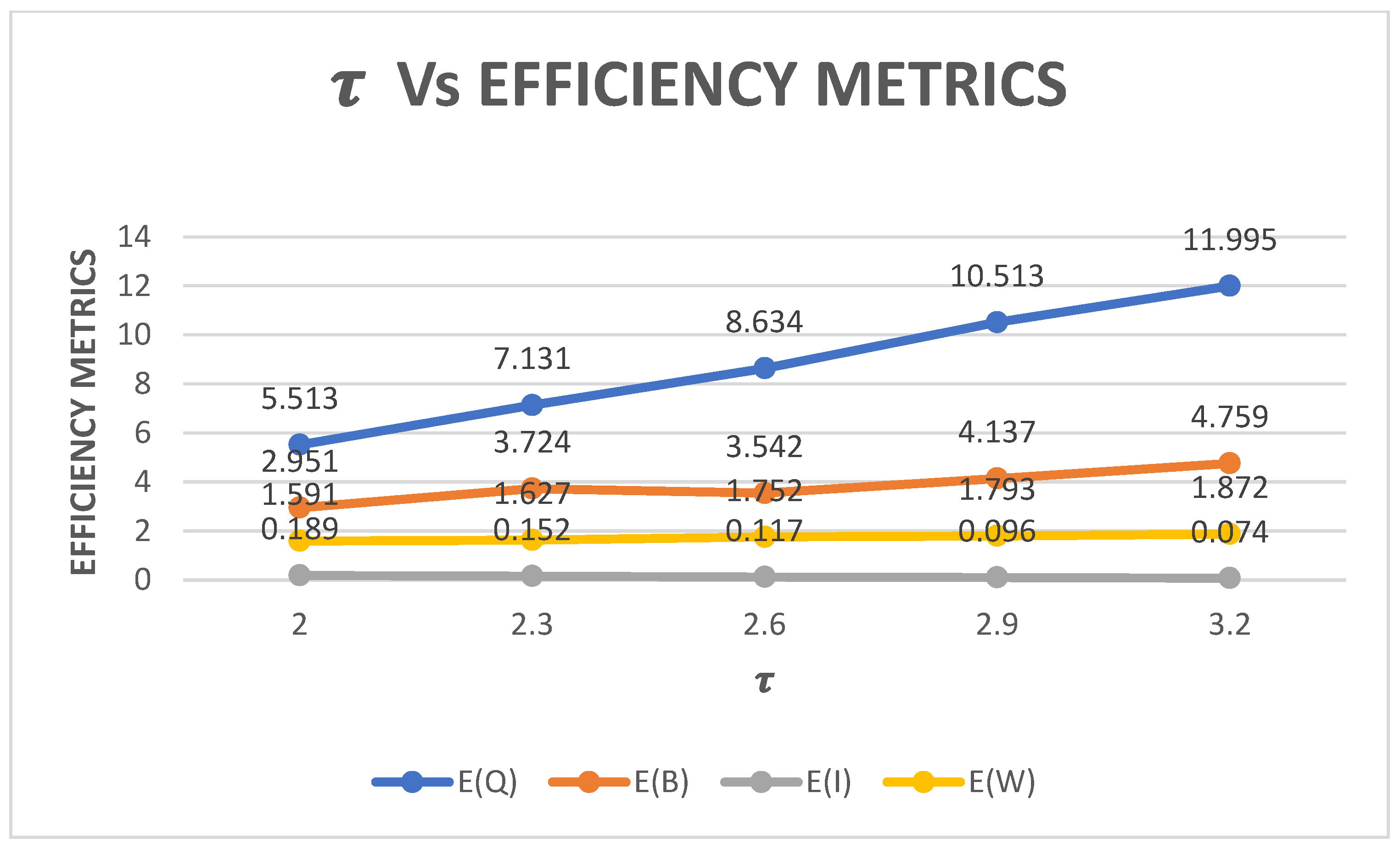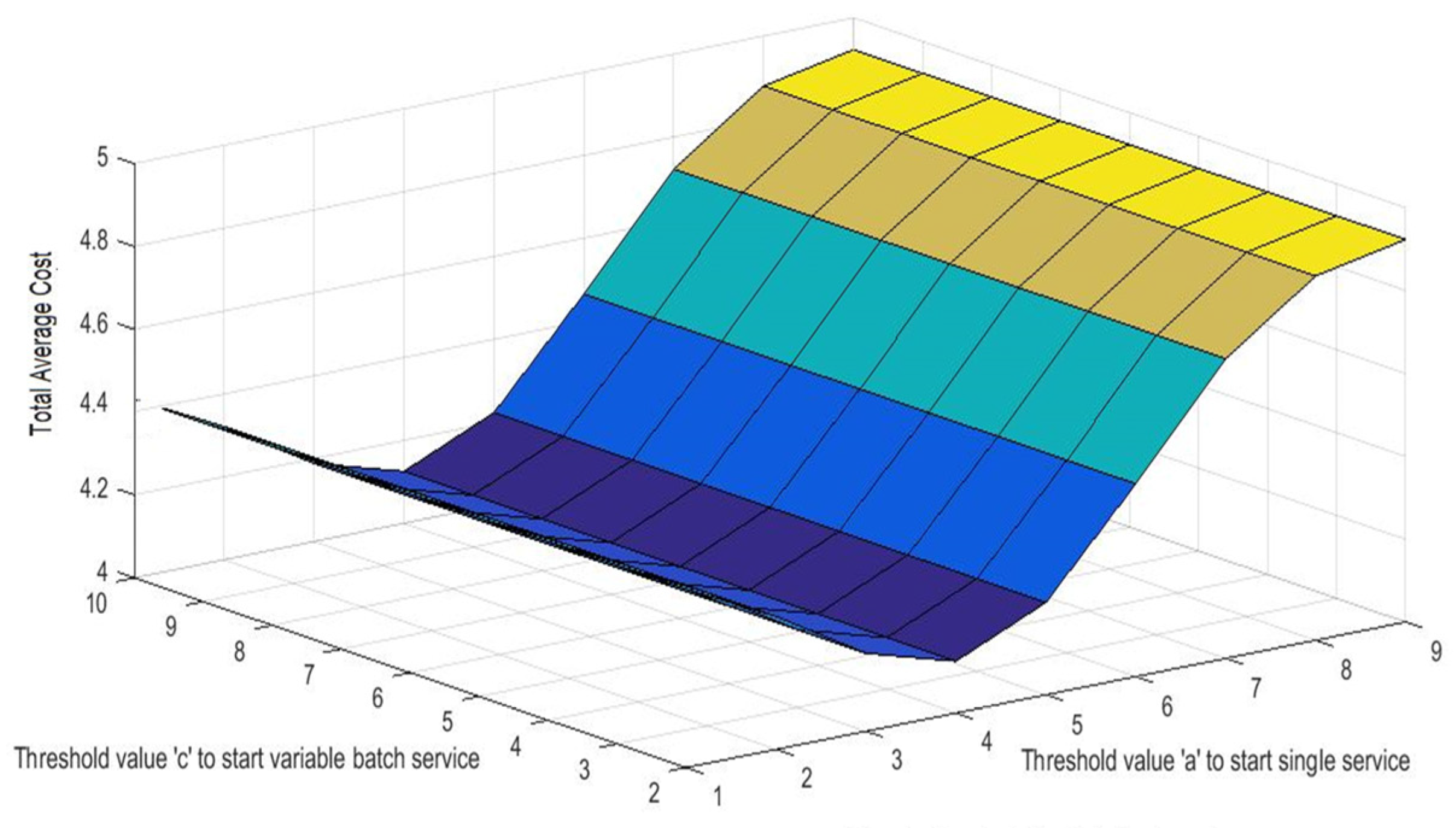1. Introduction
Several researchers have played a pivotal role in advancing the research on queueing systems involving vacation periods. Notable works feature a single-server queueing system with vacations (see [
1,
2]), vacation queueing models [
3], and a comprehensive survey on single server queues with vacation [
4]. In [
5], batch queues with extended vacations were analyzed, focusing on the N-policy and multiple vacation scenarios. However, in their model, the server is restricted to serving only one item at a time. In [
6], the bulk queueing model with a bulk service rule was introduced. Ref. [
7] recently employed the supplementary variable technique to study
, a model having vacation disruption. Ref. [
8] introduced replaceable repair in an M/G/1 new model with threshold and vacation. Ref. [
9] provided a review of classical batch arrival and bulk service.
In all the above bulk arrival queueing systems, they considered only one service mode. However, in many practical applications, to reduce congestion, more than one service mode is needed. In such systems, an operator may adjust the server’s service mode depending on the queue length. Ref. [
10] explored a method for adapting the service mode in bulk arrival queueing systems according to the current queue length. Their work is based on the Markov decision theorem. This proposed queueing system is unique in that it incorporates three different service modes into a single-server queueing model with vacation periods. Ref. [
11] investigated the steady-state conditions and conducted various performance analyses for the M
X/G/1 queueing system, incorporating possible services, postponed repairs, and multiple stages of repair. Ref. [
12] employed a supplementary variable technique to study a system represented as
which features multiple vacation periods, closedown times, and optional repairs. Ref. [
13] examined a bulk arrival queueing system, focusing on service that depends on batch size and incorporating the concept of a working vacation. In this paper, they also introduced two types of service modes during working vacations.
Ref. [
14] examined a non-Markovian bulk service queueing model featuring an unreliable server, N-policy, and Bernoulli-scheduled multiple vacations. Ref. [
15] introduced state-dependent breakdowns into a bulk arrival and batch service. By applying the supplementary variable technique, the study derived the probability function for the queue size at any given time, and metrics were calculated and demonstrated through numerical examples. Additionally, a real-time situation in existing healthcare management was also highlighted. Ref. [
16] explored phase-dependent breakdowns in a batch service queueing model. Their research introduced two distinct types of breakdowns, each corresponding to one of the two service phases. Ref. [
17] introduced a new method for constructing characterization identities for a wide range of absolutely continuous univariate distributions. By extending the explicit formula of the zero-bias distribution within Stein’s method, they obtained clear representations for the distribution function. Instead of concentrating on distributional transformations with particular structures, their focus was on offering formulas that directly capture the distributional properties.
Ref. [
18] examined queue-dependent service rates (QDSRs) in the context of a stochastic queueing-inventory system (SQIS). The system includes a single service channel, multiple inventory items, and a finite queue. Customers are served immediately upon arrival if the server is available and adequate inventory is present in the SQIS. Ref. [
19] presented a novel closed-form approximation method for analyzing multi-server, single-channel queues with non-Poisson traffic, where inter-arrival and service times follow double-tapering distributions. Ref. [
20] explored the analysis of a queueing system with three distinct classes of impatient customers, each defined by its own service time and patience time distributions. They examined the behavior of the system, considering the unique characteristics of these customer classes.
Ref. [
21] presented a valuable contribution to the study of queueing systems by extending the M
X/M/C queue to incorporate static and dynamic server groups. The utilization of the difference equations approach and the inclusion of additional features provide a comprehensive framework for analysis. Ref. [
22] conducted an in-depth study of the risk-sensitive first passage discounted cost criterion. Their analysis addresses cases involving Borel state and action spaces, accommodating unbounded costs and transition rates. Ref. [
23] addressed the issue of limited flow table space in Software-Defined Networking (SDN) switches and its effect on data plane availability. They developed a theoretical model grounded in queueing theory to estimate the state of flow tables in SDN switches, with the goal of offering insights into flow table resource needs and ensuring optimal data plane performance. Ref. [
24] explored a dynamic virtual hub location problem within transportation networks. The problem arises when a hub with limited capacity faces, congestion issues, and some or all routes passing through it need to be transferred to a virtual hub to maintain flow connectivity with minimum disruption. The goal was to alleviate congestion at the hubs and ensure a smooth flow of movement throughout the network. The researchers employed the CPLEX optimization software package to solve small sample problems. For large sample sizes, they suggested two metaheuristic algorithms: a genetic algorithm and a competitive algorithm. Ref. [
25] investigated a single server queueing model. Within this model, the author introduced a novel approach termed ‘group clearance’, characterized by a general bulk service rule. Notably, this rule allows for an unbounded batch size, enabling the server to process tasks in exceptionally large groups.
Ref. [
26] tackled peak-hour congestion in urban rail stations by introducing a simulation-based optimization method for managing passenger flow. Their approach leverages queueing networks and surrogate models to optimize flow control strategies to enhance station throughput, reduce congestion, and improve passenger experience. A two-stage process combines multi-agent simulation, a Kriging model, and particle swarm optimization to manage ingress flow, tested on Zhongguancun Station in Beijing. Results show the method reduces wait times, conserves resources, and supports a sustainable transit system. Ref. [
27] addressed challenges in bus charging stations (CSs) caused by increased demand from private vehicles, such as high electricity costs and long wait times. A dual-layer optimization model, leveraging the Golden Sine Algorithm, was used to balance construction and user costs. By integrating energy storage scheduling with an M/M/c queue model, the study sought to reduce grid load and minimize wait times. Results show a 6% reduction in electricity costs and a drop in average waiting time to 2.1 min, offering a promising solution for a more efficient and sustainable bus CS operation. Ref. [
28] addresses the challenge of dynamic real-time task offloading in a multi-user Mobile Edge Computing (MEC) network, aiming to optimize energy consumption while ensuring long-term system stability. By applying Lyapunov theory to decouple the problem and framing it as a Markov decision process, the study introduced a deep reinforcement learning (DRL)-based LMADDPG algorithm to enhance task-offloading decisions. The simulation results show that this approach improves performance over baseline algorithms in managing offloading tasks under energy constraints, ensuring better user experience and system efficiency. Ref. [
29] presents a multi-period queuing location-allocation model. This model optimizes facility locations and transportation using M/M/C/K queuing systems to improve profitability, decrease driver wait times, and minimize environmental impact. A mixed-integer nonlinear programming (MINLP) approach was utilized, with the grasshopper optimization algorithm (GOA) offering a more efficient solution to large-scale problems compared with traditional methods like GAMS. The findings indicate that GOA performs similarly to GAMS while significantly reducing processing times and effectively balancing costs, environmental impact, and wait times. Ref. [
30] presented a queueing system where customers arrive in bulk according to a Poisson process, and the service was divided into two phases: First Essential Service and Second Essential Service, with varying server capacities. Feedback after the Second Essential Service, server vacations, and system renewals was modeled with respective probabilities. The supplementary variable technique was used to derive the probability-generating function of the queue size at arbitrary times, and numerical examples were provided to illustrate the analytical results. This model addresses server utilization and dynamic queue management under various conditions.
Modeling and analysis of queueing systems with vacation play an important role in dealing with real-life congestion problems. The utilization of idle time in the bulk arrival queueing model makes systems much more realistic and flexible. These types of queueing models have practical applications in various fields, including manufacturing industries, production line systems, and communication networks. The inspiration for this particular model stems from a real-life scenario in pharmaceutical science, specifically related to the sintering process used in tablet production. Sintering is a technique that involves heating powdered material in a furnace below its melting point until the particles bond together. In this process, the components of the tablets are the customers arriving for the sintering process. The sintering furnace is the server where the components are compressed and manufactured tablets. The service mode of the server can be changed by the operator based on queue length.
In this model, the input to the sintering process arrives in batches, which are then collectively subjected to the sintering furnace for bulk treatment. The activation of the furnace hinges on the availability of a sufficient batch size, as it is optimized for larger loads. Once initiated, the furnace operation needs to be maintained consistently over multiple successive batches to avoid an escalation in operational expenses. Upon the completion of the sintering process, if the remaining components fall short of a predefined batch size ‘a’, the operator halts the sintering process and undertakes a secondary task. This secondary task could encompass activities like blending powders for subsequent procedures, cleaning external surfaces, and verifying component dimensions. Subsequent to the secondary task, the operator remains within the system, awaiting the arrival of the necessary components. This intricate sintering process can be effectively represented as a bulk queueing system characterized by a range of service modes and instances of operational downtime.
In this model, service is provided in three modes: single service, fixed batch service, and variable batch service. Even a single service will only begin when the queue length reaches ‘1000 grams’ (customers). A queue size-dependent service approach is necessary to minimize the costs. Changes in the service mode can only occur at the start of a service period. Variable batch service is available only when the queue length reaches ‘2000 grams’(customers) (2000 > 1000) and is provided based on the general bulk service rule, with batch sizes ranging from a minimum of ‘2000 grams’(customers) to a maximum of ‘4000 grams’(customers). Similarly, the server offers fixed batch service when the queue length is at least ‘10,000 grams’ (customers) (10,000 > 4000), where ‘4000 grams’ (customers) is the upper limit for varying batch service. In fixed batch service, a predetermined batch size of ‘5000 grams’ (customers) is used. After each service completion, the service mode may either change or remain the same. If the queue length is less than ‘1000 grams’ (customers), the server goes on vacation. Upon returning from vacation, the service process is reinitiated. If the queue length is still below ‘1000 grams’ (customers), the server stays idle (dormant period) until the queue length reaches the threshold required to start the service.
The main contributions of this study include the following:
We introduce three service modes for a bulk queueing system based on queue length with the intention of reducing the waiting time of customers in the queue.
Single service, fixed batch service, and variable batch service are incorporated into the same server to minimize the total average cost of the system.
Modeling a bulk queueing system with fixed batch service as one of the service modes plays a vital role in reducing the operating cost of the system.
An application for the proposed model is explained in detail based on powder metallurgy (sintering process).
The paper is structured as follows:
Section 1 presents the introduction and literature review. In
Section 2, the model description and methodology for the proposed queuing model are detailed.
Section 3 provides the stochastic model, governing equations, queue size distribution, performance measures, and special cases.
Section 4 focuses on the cost model for the system and includes numerical illustrations. Finally,
Section 5 offers the conclusion and suggestions for future work.
